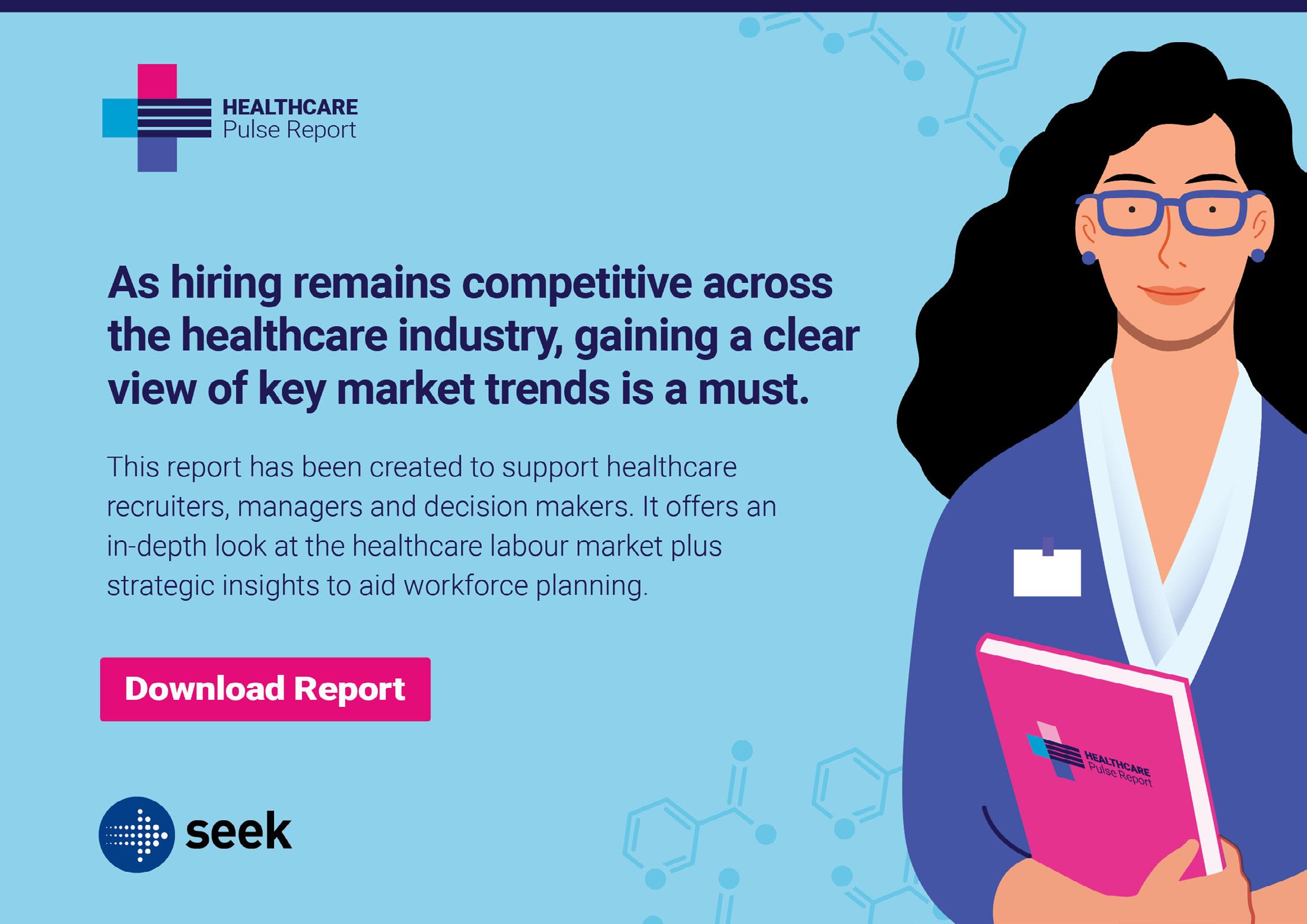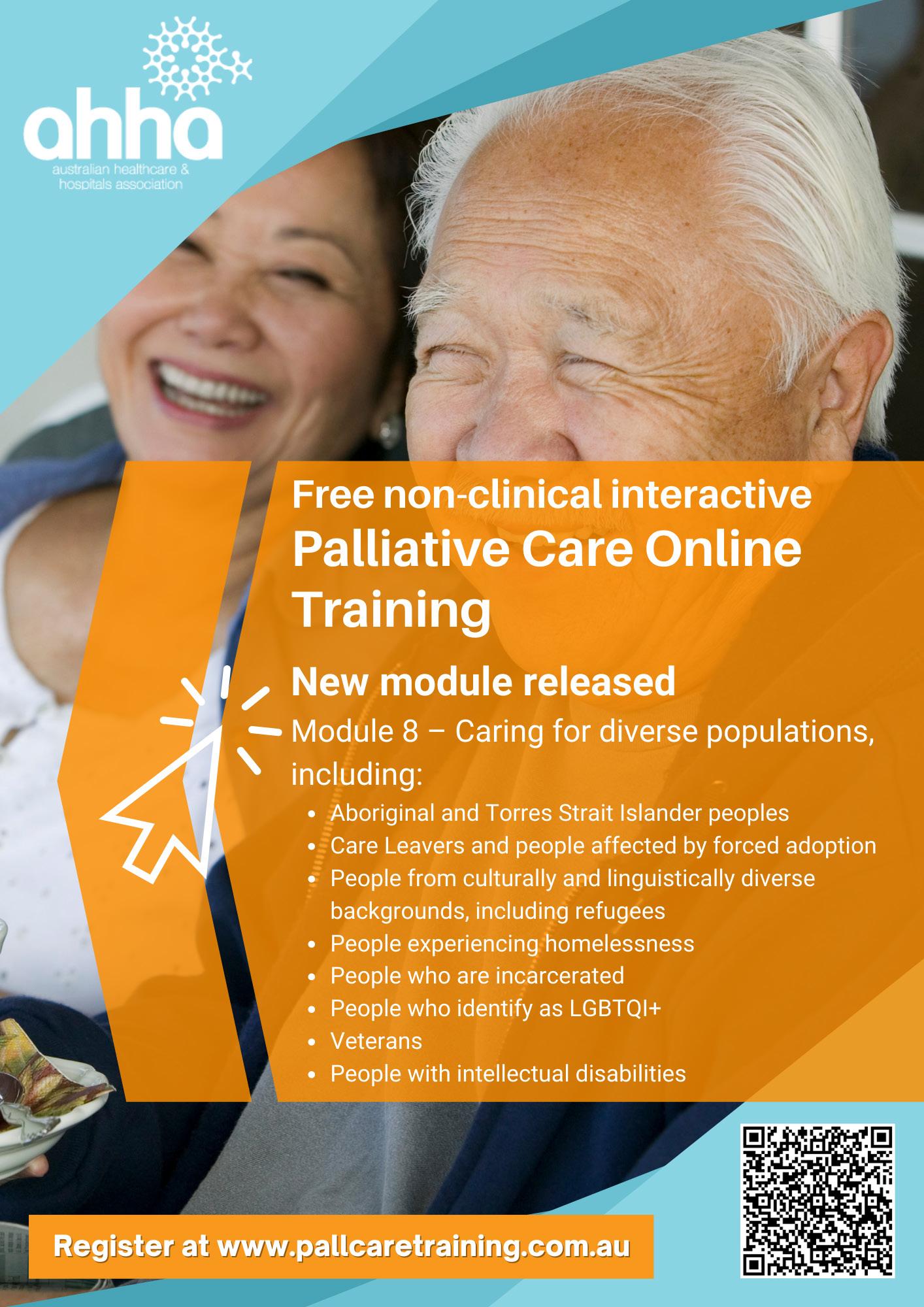




















This issue of The Health Advocate is dedicated to digital health care, the advancements we have made so far, and the road ahead as new technologies continue to develop at a rapid rate. Artificial intelligence is one such technology. Its swift adoption across all facets of life is not a reflection of new technology so much as the convergence of data proliferation, algorithmic advances and computing power and affordability. The rate of AI development is accelerating, and developments are being applied broadly across diverse industries. But is our health system set up to adopt AI in a way that best meets the needs of individual patients, providers and the population? Will investment be outcomes-focused and valuebased? Are goals of equity and sustainability ensured in our investments?
‘Health, ageing and disability’ have been identified by CSIRO as high potential areas for AI specialisation for Australia. All healthcare services in Australia are likely to be already using AI in products and processes in some form across various business units and functions. For example, virtual assistants or chatbots are increasingly being
deployed to support ‘customer service’ enquiries, such as SA Health’s ‘Zoe’ responding to the initial surge in COVID-19-related queries and triaging those that are more complex. Apps providing waiting times for services have been coupled with predicted drive times to inform patient choices about where and when to present.
In the provision of health care more specifically, the applications are diverse and the opportunities substantial. For example, AI using computer vision together with machine learning has been demonstrated to be effective in the diagnosis of melanoma and various medical imaging applications. AI has been demonstrated to be successful in interrogating clinical notes to generate meaningful information about incidents, errors and adverse events, and for chatbots for various purposes such as social and communication therapy for children with autism.
With the volume of data held within the health sector, machine learning provides significant opportunities for clinical decision support tools. Research is underway in Australia to translate AI technologies into health care, including to
detect eye and cardiovascular diseases; optimise treatments in mental health; and diagnose, treat and prevent antimicrobial resistance in hospitals. State governments are exploring the implementation of AI, for example for remote monitoring of unwell rural patients to support early detection of deterioration.
Progress is occurring in primary care too. The use of AI by GPs to predict in real-time the risk of emergency department presentation has been researched in Victoria, with further work planned to establish linked data with local hospitals, state health, pharmacies and other healthcare entities.
Introducing, sustaining, and scaling such technologies requires sector-wide attention to areas much like those needed when enabling team-based models of care, which the Australian Healthcare and Hospitals Association (AHHA) shared in a paper in 2020. With the mid-term review of the National Health Reform Agreement currently underway, it is time for strong leadership and a commitment to policies that will enable us to deliver the health outcomes that are made possible with technology. ha

“The rate of AI development is accelerating, and developments are being applied broadly across diverse industries. But is our health system set up to adopt AI in a way that best meets the needs of individual patients, providers and the population?”
2 FEBRUARY 2023




AHHA welcomed the release of the Strengthening Medicare Taskforce Report, while recognising it will be the details that matter.
Our members and stakeholders across the health ystem have long been calling for a commitment to reorient the system towards one that is personcentred, outcomes-focused and value-based. The report identified those critical enablers that will align diverse stakeholders around a shared vision.


www.ahha.asn.au
www.publish.csiro.au/journals/ahr
Australians when it comes to healthcare. It also discusses the work still to be done in the areas of institutionalised racism, access to services and cultural safety. ha
We welcome the Government’s commitment to a staged approach that will build multidisciplinary models of care around the needs of individuals and communities with complex and chronic conditions; that will introduce changes to funding models that incentivise improved health outcomes, not just more activity; and that embeds evaluation and learning so we can scale what works for the system, and the people and workforce that it serves. AHHA acknowledges that this is not a quick fix. ha
We would like to hear your opinion on these or any other healthcare issues. Send your comments and article pitches to our media inbox: communications@ahha.asn.au
2 MARCH 2023



6 APRIL 2023

01/02/2022 Towards a thriving healthcare workforce

for Health Policy Research, the Perspectives Brief ‘Digital maturity models for primary health care’ explores the role of digital maturity assessments in assisting PHC providers to fully leverage available digital assets and technologies for the benefit of both their patient base and workforce. ha
www.ahha.asn.au
www.publish.csiro.au/journals/ahr
pee -reviewed journal, focuses on healthcare financing and the costs associated with delivering healthcare in Australia.

In this issue, Policy Reflections authored by Jane Hall and Stephen Duckett reflect on Australia’s healthcare system and the growing and changing health needs of Australia. The authors question the system’s resilience and whether it is able to cope with future shocks, such as environmental catastrophes and financial crises. ha




Digital technologies are increasingly seen as an essential resource in primary care. While many health care providers across Australia have responded positively to the potential of digital technology and information systems, it is known that digital adoption and integration have considerable variability across services.
Likewise, there is significant variation in digital adoption among Primary Health Care (PHC) providers. The varying levels of adoption amongst its providers, and variable access to it amongst its consumers, raises the potential for a ‘digital divide’. To resolve this, it is imperative for stakeholders and funders to assess PHC providers’ digital infrastructure maturity.
In their recently published Perspectives Health Policy Brief from the Deeble Institute for Health Policy Research; Digital maturity models for
primary healthcare, Associate Professor Sandeep Reddy and colleagues from the Institute for Health Transformation, Deakin University and Western Victoria PHN explored the role of digital maturity assessments in assisting PHC providers to fully leverage available digital assets and technologies for the benefit of their patient base and workforce. The World Health Organisation have identified three interrelated and complementary pillars which underpin PHC:
• integrated healthcare
• multi-sectoral policy and action
• empowered communities
Integrated healthcare has an emphasis on public health and primary care functions in delivering preventative care. Multisectoral policy and action is required to systematically address determinants of health, and empower communities, meaning
healthcare has an emphasis on public health and primary care functions in delivering preventative care. Multisectoral policy and action is required to systematically address determinants of health, and empower communities, meaning that people can become codevelopers
that people can become co-developers of health services. Through the combination of these components, PHC can form a foundation for universal health coverage. Therefore, any digital health intervention in PHC and subsequent assessment requires taking these pillars into account.
Based on these pillars, digital maturity assessment requires a tool that can comprehensively evaluate the steps being taken by the providers to achieve digital health maturity. Of the existing digital maturity models, however, many models either are oriented to hospital environments or lack consideration of the PHC context, quality improvement processes, and empowerment of clients.
To identify a suitable model that meets the needs of PHC, the team identified popular digital maturity models including:
• HIMSS Electronic Medical Record Adoption Model (EMRAM)
• Victorian Digital Health Maturity Model (VDHMM)
• Gippsland PHN co-developed Digital Health Maturity Assessment (DHMA), co-developed with Semantic Consulting. The team recommended three options for PHC providers to consider.
The first option to consider is the VDHMM, a comprehensive digital health maturity model developed by the Victorian Department of Health to cater to public health service providers. This model has been evaluated by Deakin University for its validity, usefulness, and applicability. Amongst the available models, it is a very comprehensive assessment framework, has a broader focus than hospitals, and is accompanied by a questionnaire and maturity roadmap.
The second option to consider, the Gippsland PHN co-developed DHMA, was developed specifically to assess the digital readiness and maturity of general practice. The model has also been implemented in the Gippsland region and other PHNs, yielding useful information to inform the PHN’s digital health strategy and investment. The model is web-based, allowing adaptability or shared use by PHC providers.
The third option, a new model, the Digital Maturity Assessment of Primary Care Providers (DMAPP), was developed by researchers from Deakin University in consultation with Western Victoria PHN to assess pertinent aspects of digital health infrastructure and intervention within the PHC environment. DMAPP has been designed >
“Integrated
of health services.”
to align with the WHO-endorsed PHC pillars and utilises the ‘Integrated Model of Evaluation (IMoE)’ framework, which incorporates critical elements of traditional evaluation practices, while aiming to be a practical approach (Figure 1).
DMAPP presents three main components: Capacity, Change and Transformation. DMAPP envisages providers need to achieve or have the specific capacity and undertake changes to achieve
components, they achieve various maturity levels. While there are many digital maturity models available, very few have been developed for the PHC environment. In this context, it was deemed that a customised digital maturity model, now termed DMAPP, was necessary. DMAPP incorporates the three PHC pillars, emphasised by the WHO, while including essential components from popular digital maturity models. It is envisaged that

the digital transformation required. DMAPP outlines the relevant outcomes to mark the shift. In the case of DMAPP, maturity levels are denoted by five levels (Figure 2). As the PHC provider progresses through the capacity, change and transformation
DMAPP will not only help with the assessment of a provider’s current digital maturity but support their progress toward an appropriate level of digital maturity.


Digital health technology is transforming primary health care in North Queensland.
Northern Queensland Primary Health Network (NQPHN) Chief Executive Officer Robin Whyte said digital health technology is creating new health care pathways and giving patients more choices, and access to timely and quality care from health professionals.
It is also reducing the administrative burden for general practitioners (GPs) and health care providers.
‘A combination of digital health care, including telehealth and virtual care where appropriate, and collaboration between care providers is the future of health care,’ Ms Whyte said.
‘NQPHN is rolling out digital health initiatives for First Nations patients, older persons in residential aged care facilities (RACFs), and organisations upgrading and enhancing their digital technology,
which puts the patient at the centre of their own health and allows for easier access to timely care.
‘Our priority is also to reduce the administrative burden on clinicians while enabling health information continuity between providers through embracing technology-enabled care, electronic communication, and information sharing.’
NQPHN is working with providers to implement several complementary digital health initiatives that will greatly uplift the sector.
‘Digital health, including telehealth and video conferencing for patients, is being increasingly embraced by both primary health care professionals and patients as an effective consultation medium, but it can also be complex,’ Ms Whyte said.
‘The RACF telehealth project, being undertaken by Enkindle Consulting, works with participating
RACF staff to review their hardware and capability to use the technology.
‘The aim is to understand the level of maturity at each RACF across priority areas. NQPHN will then provide grants to participating RACFs in the region to upgrade their technology and support their workforce through training.’
Ms Whyte said NQPHN’s digital health maturity self-assessment tool, the Digital Maturity Matrix and Digital Maturity Roadmap, were also designed to support primary care providers to understand their current level of digital maturity.

‘The Digital Maturity Matrix and roadmap shows general practices where they are on the digital roadmap and the next steps to take to see improvement at each level,’ she said.
NQPHN Digital Capability Grant Program applicants complete the self-assessment and, on completion, receive the Digital Maturity Matrix report outlining where they sit on the roadmap.
This current round of grant funding is helping NQPHN understand the baseline digital maturity of general practices, Aboriginal Medical Services (AMSs), pharmacies (MMM 4-7), and allied health clinics in the region.
Ms Whyte said the NQPHN Digital Capability Grants Program aimed to help primary care providers in the region grow and develop a seamless digital health care service for their patients.
Meanwhile, digital tools are giving health care professionals in the North a more holistic view of patient health through data access. >
Robin Whyte, CEO, NQPHN
‘A combination of digital health care, including telehealth and virtual care where appropriate, and collaboration between care providers is the future of health care,’
‘We know digital health offers opportunities to improve medical outcomes and enhance efficiency for GPs and patients, which we are seeing with
the rollout of the INCA shared-care platform as part the 12-month First Nations Continuous Quality Improvement (CQI) program,’ Ms Whyte said.

‘One of the biggest issues health professionals face is that patient health care plans and information is not automatically available for other clinicians to view.
‘The INCA system makes it easier for health care providers to coordinate and manage complex and chronic health conditions in community settings outside of hospital, sharing the individual’s health information quickly and accurately between the patient’s broader health care team.’
Innisfail GP Dr John Di Palma was the first general practice to go live with INCA in October 2022 and calls it a ‘one-stop-shop’ program.

‘We have noticed a major increase in First Nations patients using INCA,’ Dr Di Palma said. ‘It’s more visual for patients, which has increased their engagement with health and quality care.
‘It is also promoting conversations and identifying areas where allied health services can have input for better health outcomes and has definitely helped to cut down on paperwork time. INCA has enabled our practice nurse to have serious talks with patients and care givers, and input that information into INCA to give a much more holistic picture.’
Since the COVID-19 pandemic, NQPHN has seen an acceleration in the use of digital technology, but
some health professionals are being left behind and may question the value digital technologies provide.
‘Digital tools can only benefit the health sector if they are put to meaningful use by health providers and their patients,’ Ms Whyte said.
‘NQPHN is currently developing a Continuous Quality Improvement (CQI) program to raise awareness of the benefits of using digital technologies, including to decrease the administrative burdens when treating patients with chronic or complex conditions.’
NQPHN will continue working with primary health care providers to ensure they have compatible digital infrastructure, software, and training. ha


Canberra Head to Health provides free and accessible mental health services to adults in the ACT, without an appointment or referral. Staffed by a multidisciplinary team of psychologists, mental health workers and social workers, the Centre provides free mental health support inperson, online or over the phone. Capital Health Network (CHN), ACT’s Primary Health Network, commissioned Think Mental Health to develop nd deliver this essential service to the Canberra community.
New robust digital health platform
CHN and Think Mental Health needed to identify an innovative digital health solution to support Canberra Head to Health’s coordination of care. Eighteen months ago, CHN supported Think Mental
Health to identify their digital health needs and select an appropriate digital health provider. Think Mental Health selected CareMonitor’s remote patient monitoring system and Initial Assessment Referral Decision Support Tool. This bespoke, secure digital health platform supports service navigation and communication between multidisciplinary care teams, improves internal workflow, clinical delivery, patient reach, communication, engagement and health outcomes. The fit-for-purpose digital health platform provides a standardised intake assessment to thoroughly understand the patient’s needs, assisting them in connecting to the best resources and services, to meet their specific circumstances and needs.

Think Mental Health’s Clinical Psychologist and Director, Jason McCrae, said they needed a digital health platform to help patients and providers engage with the mental health ‘system’ through one digital health platform.

‘People experiencing mental health issues are often faced with many barriers to connecting with effective treatment, like long wait lists, difficulty attending in-person appointments, and repeating their story with each new clinician. By utilising CareMonitor as a common platform, we’re making it easier for a patient to connect with multiple providers, find the ‘right’ clinician for them and minimize the chances of barriers halting their patient journey,’ said Mr McCrae.
The new Canberra Head to Health platform empowers patients to access resources and care in their own time, and when they need it most.
‘The rapid implementation of the brand-new assessment and model of care with complex and comprehensive governmental reporting requirements in a very short time frame has been a success. The CareMonitor product has also provided assistance in minimising patient dropout, connecting and navigating mental health services and providers, and assisting patients who had ‘slipped through the cracks’ to reconnect with the right mental health services for them’, said Mr McCrae. >
“People experiencing mental health issues are often faced with many barriers to connecting with effective treatment, like long wait lists, difficulty attending inperson appointments, and repeating their story with each new clinician.”
CareMonitor founder and CEO, Deepak Biswal said that virtual care has become a valued tool for people when they’re accessing health care.
‘Virtual care offers advantages such as selfmanagement, anonymity, convenience and cost-effectiveness. However, it is essential that this type of treatment meets the needs of both the patient and clinician to achieve successful outcomes. The reduction in patient dropouts and strong take-up of the Head to Health program generally demonstrates that accessible and effective blended (face-to-face and virtual) care can be a game-changer for patients in managing their mental health’, said Mr Biswal.
Canberra Head to Health is supported by funding from the ACT PHN through the Australian Government’s PHN Program. You can contact Canberra Head to Health here.

Tim* (not his real name) first requested a ‘call back’ from our Head to Health Centre via our webpage. Tim was called by one of our clinicians and completed an Intake Assessment and Referral clinical interview with all data recorded via CareMonitor’s platform. Tim had found it challenging to seek help in the past but used CareMonitor’s platform to take the appointment via telehealth and to complete psychological assessment items.
Following his triage by Think Mental Health senior clinicians, Tim was provided with a resource pack through CareMonitor’s digital platform, including trauma informed cognitive-behavioural therapy and exposure-based therapy. He was also given a referral to ‘This Way Up,’ an internetdelivered cognitive-behavioural program addressing obsessive and compulsive symptoms, which was run concurrently with Tim’s sessions at Head to Health. He was also connected with a community psychiatrist for a comprehensive psychiatric assessment.
The use of the CareMonitor digital platform, in conjunction with Think Mental Health’s clinical expertise, allowed Tim to overcome barriers to connecting to quality mental health care both digitally and in-person from a wide care team. Most importantly, Tim made many gains and recovered from depression while also managing the obsessive-compulsive disorder symptoms highly effectively.
Reference to CareMonitor does not imply an endorsement or mutual sponsorship by CHN. ha
“The reduction in patient dropouts and strong take-up of the Head to Health program generally demonstrates that accessible and effective blended (face-to-face and virtual) care can be a game-changer for patients in managing their mental health.”

Increasingly, people with chronic conditions such as Type 2 diabetes are expected to take care of their health at home, and reduce visits to medical settings such as GPs and hospitals. While it may sound straightforward that a well-controlled diet, exercise and blood glucose monitoring are central to living well with Type 2 diabetes, many individuals struggle to practise self-management effectively. They also do not always self-report how they are managing accurately—they may not even be aware of the self-care activities they undertake or miss—sometimes leading to suboptimal care.
In order to obtain a more accurate understanding of how people over 65 years of age are managing self-care with Type 2 diabetes and comorbidities, we used wearable cameras to capture their daily activities with the aim of designing better support. We were also motivated
by the knowledge that when self-care is not well integrated into someone’s life, it becomes burdensome and likely to generate additional stress, potentially leading to non-compliance.
Importantly, this research was about helping people to see where they might improve their self-care and therefore better protect their health and well-being by identifying behaviours they may not even be aware of, and to help others embarking on the self-care journey. We were very appreciative of people sharing a small part of their lives with us for this research.
This is the first study of its type in the world and was carefully designed to protect people’s privacy. The use of machine learning to classify the 400 hours of footage captured by the cameras was also innovative and paves the way for more of this type of first-person point-of-view research. >
DR ANNIE LAUAustralian Institute of Health Innovation, Macquarie University
“This is the first study of its type in the world and was carefully designed to protect people’s privacy.”
So what did we find? The results proved invaluable to not only show participants their behaviours and routines involved in the work of self-care, but also to share with others recently diagnosed, what they may expect when undertaking self-care.
Privacy and safety issues were taken very seriously when designing this study which was undertaken with strict protocols. For instance, participants could review and delete any footage before sharing with researchers. Participants were also asked to keep a diary to record health related tasks, including for instance when they took medication or made a meal.
Participants were also provided a card to show people who might have been curious or concerned about them wearing a camera in a public setting, such as the supermarket. The card explained the research program, noted the privacy protocols in place and provided contact details for the research team.
After participants wore the camera and kept the diary for 24 hours, the research team used machine learning to automatically classify the day’s activities e.g. eating, sleeping. This was achieved with a remarkable 87% accuracy. Researchers could then refer to these snippets when they sat down with participants to review footage from the day.

When we showed the camera footage back to participants, some people responded ‘I already know I do that’ while others were surprised.
One elderly person had said prior to the study that he had ‘…done everything possible to keep my blood glucose under control but nothing was working.’ The camera footage showed that every meal was accompanied by a glass of soft drink. After seeing the footage that man acknowledged it was a habit that he’d never shared with his doctor when they’d discussed his poorly controlled blood glucose levels.
Another participant saw themselves falling asleep in front of the TV for hours during the day
“The results proved invaluable to not only show participants their behaviours and routines involved in the work of self-care, but also to share with others recently diagnosed, what they may expect when undertaking self-care.”
and reflected on how they didn’t know they did this so often, leaving no time for exercise.
These examples demonstrate the utility of the data to show people behaviours, potentially detrimental to their health, that they are either not aware of or had not felt able to share. With more accurate understanding of people’s actual self-care behaviour, more personalised systems of support can be offered.

The second phase of the research went a step further to assist people recently diagnosed and new to self-care for Type 2 diabetes. The original camera footage was deidentified and used to create eight personas to exemplify typical behaviours—giving a glimpse into the real world of people coping with a chronic condition at home. The categorisation was done in relation to diet, physical activity and social context—all known factors impacting people’s self-care for Type 2 diabetes. New participants were then asked to identify their own behaviours in the personas they saw.
More than 74% of participants from the original study and the new participants from the second stage, agreed that the personas were accurate representations of their self-care routines, some saying ‘These are my behaviours’ or ‘These are my challenges’.
One persona for instance, was of a person who generally ate (diet) and exercised well (physical activity) except when in the company of family (social context) who ordered takeaway food and didn’t exercise, influencing them to do the same, to the detriment of their own health.
While the self-care approach is widely promoted to empower people, improve health outcomes, and reduce pressure on the overstretched health system, many individuals living with chronic conditions struggle to practise self-management effectively. Our research has shown that the use of first-person point of view data and personas to depict real life behaviours and routines can be invaluable to support people in the work of self-care, and in the design of better support systems. ha
“Theuseofmachinelearningtoclassifythe400hoursoffootagecapturedby the cameraswasalsoinnovativeandpavesthewayformoreofthistypeoffirstpersonpoint-of-viewresearch.”
Fatigue is one of the most common and debilitating symptoms people with multiple sclerosis (MS) experience, affecting up to 95% of people with the condition. A new online program from Germany, now tested in Australia, could lessen the impact fatigue is having on people with MS in Australia and improve their quality of life.
In Australia, there are over 33,000 people with MS, a chronic autoimmune neurological condition that causes a person’s immune system to attack the fatty material of the nerves. The symptoms of MS vary, with no two people experiencing it in the same way. However, one symptom that affects almost all people with MS is fatigue.
‘Fatigue affects every aspect of a person’s life, from working to parenting and relationships,’ Dr Jo Lane, a clinical psychologist and research fellow at The Australian National University (ANU), says.

W hile various treatments are available for MS, there is still a need for interventions that specifically target MS-related fatigue.
A new self-guided, interactive online program called elevida aims to reduce fatigue in MS. Based on the principles of cognitive behavioural therapy, elevida helps people with MS better understand fatigue, manage sleep and exercise, cope with stress, and recognise and change negative thought patterns. It provides people with MS with tools and resources like educational videos and practical exercises.
The program was originally developed by German company GAIA AG in cooperation with a research team led by Prof Gold, Charité Universitätsmedizin Berlin, and a team at Universitätsklinikum Hamburg-Eppendorf. In a collaboration with the German research team, ANU researchers have now examined the acceptability and feasibility of the English version of elevida with people with MS in Australia.
‘Interventions to address multi-faceted problems such as fatigue in MS are often under-researched due to their complexity. This collaboration is a fantastic opportunity,’ says ANU Professor Nicolas Cherbuin, a member of the research team.

The study, funded by MS Australia, has gathered the feedback of those completing the program, and will now inform further research.
‘The participants told us what they liked and didn’t like about the program as well as their experiences of fatigue,’ Dr Lane says.
‘Overall, our results indicate that the English version of the program was found to be acceptable, feasible, and suitable for people with MS-related fatigue.’
Dr Lane is part of Our Health in Our Hands (OHIOH), a strategic initiative of the ANU. The multi-disciplinary initiative aims to develop innovative personalised precision medicine for
people with chronic conditions, initially focusing on diabetes and MS, by co-creating across disciplines, professions, and areas of expertise. OHIOH involves clinicians and researchers from various fields, including chemistry, computing, engineering, medicine, physics, and psychology.
People with lived health experience play an integral role in OHIOH. They inform OHIOH’s research every step of the way, from choosing research topics to designing studies and testing new devices and programs.
‘One participant in our study knew about the German version of elevida. He was very excited to be part of the study to examine the English version,’ Dr Lane notes.
‘Our team aims to further advance the research in MS-related fatigue and to develop a personalised approach to measuring and characterising this symptom,’ Associate Professor Anne Bruestle, the Chair of OHIOH, says.
“Based on the principles of cognitive behavioural therapy, elevida helps people with MS better understand fatigue, manage sleep and exercise, cope with stress, and recognise and change negative thought patterns.”PHOTO BY MEIYING NG
Unfortunately, MS-related fatigue is invisible to others. As a result, people with MS frequently say others don’t understand or take this symptom seriously.
‘I experience fatigue constantly. Everyone knows what it’s like to be tired, but MS-related fatigue is different,’ David, a person with MS who completed the elevida study, states.

M S-related fatigue is also very subjective, with researchers and clinicians requiring people with MS to describe their experiences of the phenomenon.
‘At OHIOH, we combine self-reported and measurable psychological and physiological factors. By analysing them with machine learning approaches we aim to make this invisible symptom measurable,’ says Associate Professor Bruestle.
‘Once measurable, digital programs and apps will allow people with MS to measure and track the psychological and physiological symptoms
they experience, including fatigue, at the convenience of their home,’ Professor Hanna Suominen, Executive Leader (Computing and Engineering) of OHIOH, explains.
‘Machine learning approaches help us explore combinations of the reported experiences and measured factors, as well as their possible correlations and causalities,’ she notes.
Associate Professor Bruestle concludes, ‘Our research will help define a clear individualised picture of MS-related fatigue and fundamentally advance our understanding of it.
‘Not only will this empower people with MS and directly impact their quality of life, but also provide guidance for clinicians.’ ha
Do you have lived experience with MS and would like to contribute to OHIOH’s research?
Visit our website to learn more.
“At OHIOH, we combine self-reported and measurable psychological and physiological factors. By analysing them with machine learning approaches we aim to make this invisible symptom measurable.”

The HESTA private equity portfolio was our top performing asset class in 2021, helping to drive strong returns for our members. We aim to continue this trend with an exciting addition to the HESTA private equity portfolio. In November last year, HESTA acquired a $120M equity stake in the newly combined Genie Solutions and Citadel Group.
Citadel is a global software and services firm specialising in markets such as healthcare. Similarly, Genie Solutions is Australia’s leading practice management software for medical professionals. Together, they are forming an exciting venture as the sector rapidly expands, bringing with it more digital support options for
healthcare services and improving the clinical experience for patients.

HESTA, who originally invested in Genie in 2017, chose to reinvest proceeds from the recent sale of Genie into the newly combined Citadel Group, maintaining our exposure to a fast-growing business and the digital healthcare sector more broadly.
“We’re proud to be continuing to invest in the next chapter of Genie Solutions’ growth”, Sonya says. “Our investment in Citadel Group will give us exposure to a group of companies providing healthcare and enterprise software services in Australia and globally.”
HESTA has recently expanded its investments into an exciting private equity opportunity in digital healthcare.
Investment in private equity gives our members access to some of the most innovative companies in the early stage of their business life. And with an injection of capital from HESTA, these companies are able to grow and thrive.

Just as importantly for our members, our private equity investments have also delivered fantastic financial outcomes. In 2021, our private equity asset class returned more than double listed market benchmarks. We aim to keep delivering strong Private Equity returns in the long term.
Issued by H.E.S.T. Australia Ltd ABN 66 006 818 695 AFSL 235249, the Trustee of HESTA ABN 64 971 749 321.This information is of a general nature. It does not take into account your objectives, financial situation or specific needs so you should look at your own financial position and requirements before making a decision. You may wish to consult an adviser when doing this. The target market determination for HESTA products can be found at hesta.com.au/ tmd. Before making a decision about HESTA products you should read the relevant Product Disclosure Statement (call 1800 813 327 or visit hesta.com.au for a copy) and consider any relevant risks (visit hesta.com.au/understandingrisk).
“Investments like this are helping improve our members’ experience at work, while also supporting digital innovation in their sector.”
Sonya Sawtell-Rickson, HESTA Chief Investment Officer
“Through their super, our members are helping commercialise lifesaving medical breakthroughs, developing cutting-edge clean tech to tackle climate change and future- proofing the sectors in which they work by supporting digital innovation”, Sonya says.
digital innovation in their sector.”
As populations around the world age and people live longer, interoperability and data sharing is going to become increasingly critical for delivering effective healthcare.
According to the Australian Bureau of Statistics, more than three-quarters (78.6 %) of Australians had at least one long-term health condition in 2020-21. Almost half of all Australians (46.6 % or 11.6 million) had at least one chronic condition.
South Western Sydney Primary Health Network (SWSPHN) is invested in driving innovative models of care which empower the individual to better manage their health.
SWSPHN has been working with Altera Digital Health since 2017 to pioneer iRAD (Integrated Real- time Active Data), which uses the dbMotion Solution to enable critical patient data to be instantly shared between hospitals, GPs and other healthcare providers.
SWSPHN CEO, Dr Keith McDonald, PhD, says iRAD delivers an interoperability system that connects health providers — improving patient care with the secure, timely and accurate sharing of patient information.
‘Delivering the right care to the right patient at the right time is only possible with interoperability,’ he said.

“Investments like this are helping improve our members’ experience at work, while also supporting
Dr Keith McDonald PhD, Chief Executive Officer, South Western Sydney Primary Health Network
What is interoperability and why is it important?
Interoperability is about sharing information with a consistent meaning and how we move it between people, organisations and systems. This is challenging in healthcare due to disparate disconnected silos of information which have evolved using varied technology platforms.
What makes iRAD different?
iRAD:
• It is patient-centric. Its opt-in model empowers the patient to choose their care partners by giving consent to the practitioners they trust with their health data. It is a simple one-off sign-up at each care location.
• Shares information in real-time. Clinicians can make quicker clinical decisions when accessing accurate, objective patient data in real time.
• Filters and organises information into a userfriendly format. Rather than having to wade through a mountain of individual documents, iRAD syncs the information into categories or ‘domains’ so all related information is under the same section. By default, clinicians are shown information from outside their practice. To make iRAD easier to use, recent changes and updates are shown at the corresponding category or ‘domain’.
• Uploads actions on consented patient records automatically, eliminating the administrative burden for clinicians and practices
• Supports coordinated care. Patients with complex conditions and multiple comorbidities utilise services from many providers to manage their care. iRAD supports coordinated patient care by enabling access to the latest information and providing longitudinal patient records to the care team.

Examples include:
• Residential aged care and palliative care
• Patients attending After Hours clinics
• Integrated care initiatives
• Complex patients who struggle to recall their clinical history
• Low health literacy/language barriers/nonverbal
• Children who utilise multiple primary care settings
• COVID-19 patients referred to other care locations
Information available on iRAD includes: medications; allergies; pathology and radiology results; immunisations; conditions (current and past); consultation dates; documents; and COVID-19 positive alerts.
Information has so far been shared about: 65,000 medications; 55,000 conditions; 20,000 documents; and 5,600 procedures.
iRAD has been instrumental to the success of the pilot phase of SWSPHN’s My Care Partners.
In partnership with the South Western Sydney Local Health District, SWSPHN launched the first wave of My Care Partners, a program aimed at supporting people with chronic or complex health needs avoid unnecessary hospitalisation, in late 2021. iRAD software was installed in all practices participating in the program.
Dr McDonald said the results had been impressive.
‘My Care Partners and iRAD’s interoperability technology has increased the efficiency of
patient monitoring through general practice, and early indications are that it is already having a significant impact on emergency department presentations and hospital admissions,’ he said. Examples include:
• The patient attended the GP practice and an image of the wound was saved to the iRAD medical record. The patient’s care team was able to view the images and advise on care accordingly.
• iR AD information enabled the care team to prompt the patient to follow-up actions. This increased patient health literacy and patient care and medication compliance.
• The patient was suspected of COVID-19 symptoms. iRAD revealed the patient was immobile and had no access to transport. Mobile COVID testing was organised for an in-home testing team.
iRAD is operating in more than 95 care locations in South Western Sydney, and more than 10,000 patients have consented to share their health information.
The project is currently in a scale-up phase, continually increasing the number of clinicians and consented patients using the platform.
We will be partnering with additional PHNs and other state-based health services so we can grow the capacity, reach and usefulness of IRAD. ha
Health professionals can visit the SWSPHN website (https://swsphn.com.au/news/irad-theperfect-interoperability-solution-for-healthcarein-australia/) to find more information about iRAD.
“The project is currently in a scale-up phase, continually increasing the number of clinicians and consented patients using the platform.”
Primary care clinicians can access free, evidence-based resources about palliative care and advance care planning in the ELDAC Primary Care Toolkit.


This free online Toolkit contains:
•Clincial tools and resources across eight key areas relevant to your older patients;
•Education, training and quality improvement strategies;
•Resources to improve coordination and cooperation between services and providers; and
•Information on how to access and develop local HealthPathways.
Visit the Primary Care Toolkit on the ELDAC website to get started today.
eldac.com.au



Digital Health, broadly defined as ‘the use of digital technologies for health’1 encompasses the past innovations of health Information Communications Technology (ICT) and eHealth and the use of newer technologies, including telehealth, electronic health records, mobile devices, applications, wearables, blockchain and artificial intelligence. While the use of digital health technologies (DHTs) has been steadily increasing over the past ten years, the COVID-19 pandemic accelerated adoption across healthcare, research, government, and industry. In Australia, these technologies have paved the way for opportunities for improving healthcare delivery and outcomes at scale. However, in parallel to the growth of DHTs, a conversation about digital health equity has been raised to ensure we avoid leaving marginalised communities behind.
Digital health equity can be defined as the equitable experience of, equitable access to and equitable outcomes from digital health technologies regardless of location, socioeconomic status, race, ethnicity or other demographic factors. The aim of digital health equity is to reduce digital health disparities by increasing inclusion and diversity and ensuring that everyone has access to the same quality of digitally enabled care. While DHTs show promise for improving the quality and safety of patient care and population health, insufficient consideration of equity and accessibility issues can potentially exacerbate existing health disparities.2 In fact, poorly designed DHTs can worsen health outcomes of socially marginalised or disadvantaged populations. For example, the lack of diverse racial inclusion in development and data when generating AI-health algorithms may introduce negative biases resulting in preferential treatments to a particular
racial group.3 Therefore, equity in digital innovation, or the funding, research, design, development, implementation, and evaluation of digital health solutions, can also be included in the overarching concept of digital health equity.4,5
Despite the potential benefits of digital health technologies for promoting health equity, there are several individual, community and societal barriers that need to be addressed to make digital health equity a practical reality. At an individual level, these include:
• Access and affordability to maintaining, and utilising devices and software solutions;
• Staff and consumer skills, capability, and motivation to use and engage with the technology; and

• Digital literacy or the ability to search for, acquire, and understand digital information and interfaces.
One of the biggest barriers to achieving digital health equity is the digital divide, which refers to the gap between those who have access to digital technologies and those who do not. This gap is particularly pronounced in low-income and rural communities, as well as among older adults and people with disabilities. Just as the social determinants of health such as safe housing, education, job opportunities, and access to services influence health disparities, digital determinants of health such as access, confidence, attitudes, and motivation to use technology, can also affect health outcomes.2 Therefore, addressing the digital divide, digital inclusion and the digital determinants of health will have a cascading effect on this challenge.6
“Digital health equity can be defined as the equitable experience of, equitable access to and equitable outcomes from digital health technologies regardless of location, socioeconomic status, race, ethnicity or other demographic factors.”
There are various levels and ways to operationalise digital health equity in healthcare services. In addition to the points above, academics and practitioners agree other critical dimensions include:7,8
• Trust, safety, and security when interacting with the solutions and IT systems;
• The design of the content, solution format, delivery mode, social and cultural factors that affects the user experience; and
• System-level influences of legislation, regulation and policy, and the funding of research and development into these technologies. To operationalise digital health equity, policies must be put in place to ensure that digital health technologies are accessible, affordable, secure, and designed with the end-user across all stages of the research and development pathway. Healthcare providers must be trained to use digital health technologies effectively and to provide digitally enhanced healthcare that is culturally sensitive, responsive, and motivating for their patients. Finally, policy makers, legislators, governments, and grant bodies need to address the broader societal inequities of digital health innovation, critically evaluating where funding is provided, by whom and for what solutions to ensure the needs of marginalised communities are not overlooked. Digital health equity is an emerging critical issue in healthcare that must be addressed to ensure that everyone has access to the same experience of quality care. Whilst this is not an easy challenge, the points raised in this article can help to
systematically address digital health equity in a healthcare organisation. It is only through constant vigilance, critical evaluation of current practice and update of existing processes will digital health equity become a practical reality. ha
For more information on how to make digital health equity a practical reality, the Centre for Digital Transformation of Health has a series of free talks available on their website, and you can also join the global digital health equity community on LinkedIn for regular discussions. Talks: https://mdhs.unimelb.edu.au/digitalhealth/ engage/making-digital-health-equity-a-practicalreality
LinkedIn Group: https://www.linkedin.com/ groups/12754033/
References:
1.World Health Organization, Recommendations on digital interventions for health system strengthening, in World Health Organization. 2019. p. 2020-10.
2.Lawrence, K., Digital Health Equity. Exon Publications, 2022: p.121-130.
3.Nyariro, M., E. Emami, and S. Abbasgholizadeh Rahimi. Integrating Equity, Diversity, and Inclusion throughout the lifecycle of Artificial Intelligence in health. in 13th Augmented Human International Conference. 2022.
4.Richardson, S., et al., A framework for digital health equity. npj Digital Medicine, 2022. 5(1): p. 1-6.
5.Gallifant, J., et al., Equity should be fundamental to the emergence of innovation. PLOS Digit Health, 2023. 2(4): p. e0000224.
6.Sieck, C.J., et al., Digital inclusion as a social determinant of health. NPJ Digital Medicine, 2021. 4(1): p. 52.
7.Latulippe, K., C. Hamel, and D. Giroux, Social health inequalities and eHealth: a literature review with qualitative synthesis of theoretical and empirical studies. Journal of medical Internet research, 2017. 19(4): p. e136.
8.Bloom, S., Addressing health inequity through the use of technology. 2022. p. 16.
“Digital health equity is an emerging critical issue in healthcare that must be addressed to ensure that everyone has access to the same experience of quality care.”


Rapid innovation in technology has driven significant changes to the ability of software to support health outcomes. Devices utilising software, including stand alone software products, have given rise to a large number of products able to inform, drive or make clinical decisions, or directly provide therapy to individuals. If you are purchasing devices that incorporate software, plugging in devices with digital capability or standalone software for downloading or interacting with platforms or apps, the following may provide useful information.
Software is a medical device if it fits within the definition of a medical device in section 41BD of the Therapeutic Goods Act 1989, (unless otherwise excluded). Software based medical devices are medical devices that incorporate software or are software, or software that relies on other medical devices to function as intended. These are regulated in Australia by the Therapeutic Goods Administration (TGA).
These software products are also increasingly known as ‘digital’ technologies; they may function on either general computing platforms (such as >
technology advancements have led to a large increase in the number of software products available in the market that function as a medical device or Software as a Medical Device.”

computers, mobile phones or tablets), or require specialised hardware to perform their intended function. This could also include any kind of software, such as computer programs a nd applications, mobile apps, software as a service (cloud based), websites and browser delivered products.
The TGA has implemented significant reforms to the regulation of software-based medical devices, including Software as a Medical Device. Recent technology advancements have led to a large increase in the number of software products available in the market that function as a medical device or Software as a Medical Device. These advances in computing technology, coupled with easier and quicker access to software products required TGA to publish detailed clarification and a number of reforms to ensure patient safety.
It is important that developers know and understand their obligations if their software is
medical device. Some software developers may not be aware that their software requires TGA approval or that they have ongoing regulatory obligations. Software would generally be a medical device if it is intended to be used for:
• diagnosis, prevention, monitoring, prediction, prognosis or treatment of a disease, injury or disability. (Monitoring in this instance refers specifically to the active, clinical monitoring of a disease, injury or disability.)
• compensation for an injury or disability
• investigation of the anatomy or of a physiological process
• to control conception
SME Assist is a dedicated service TGA offers to help small to medium enterprises (SMEs), researchers, start-ups and those unfamiliar with regulation to understand their regulatory and legislative obligations.
“Recent
The TGA has also partnered with ANDHealth to supports Australian SMEs to navigate the regulatory guidance and compliance requirements for Software as a Medical Device.

Various guidance documents published on the TGA website provide information to help developers clarify if their software is subject to TGA oversight. In addition, the frequently asked questions section on the website were developed in collaboration with the software industry to help support developers understand what is required to meet the Software as a Medical Device regulatory obligations in Australia.
The TGA is a founding member of the International Medical Device Regulators Forum, a group of medical device regulators from around the world who meet regularly to address current challenges in regulating medical devices, and to accelerate harmonisation of regulation. The IMDRF published four technical
guidance documents relating to the regulation of Software as a Medical Device available on the IMDRF Documents webpage. Together, they cover the definition of Software as a Medical Device, as well as how existing regulatory tools such as quality management and clinical evidence can be applied. ha
The technical guidance documents are:
• Software as a Medical Device: Key Definitions
• Software as a Medical Device: Possible Framework for Risk Categorization and Corresponding Considerations
• Software as a Medical Device: Application of Quality Management System
• Software as a Medical Device: Clinical Evaluation
For further information or for Software as a Medical Device queries, contact the TGA via digital.devices@health.gov.au.
The Australian Healthcare and Hospitals Association (AHHA) is the ‘voice of public healthcare’. We have been Australia’s independent peak body for public and not-forprofit hospitals and healthcare for over 70 years.
Our vision is a healthy Australia, supported by the best possible healthcare system. AHHA works by bringing perspectives from across the healthcare system together to advocate for effective, accessible, equitable and sustainable healthcare focused on quality outcomes to benefit the whole community.
We build networks, we share ideas, we advocate and we consult. Our advocacy and thought leadership is backed by high quality research, events and courses, consultancy services and our publications.
AHHA is committed to working with all stakeholders from
across the health sector and membership is open to any individual or organisation whose aims or activities are connected with one or more of the following:
• the provision of publiclyfunded hospital or healthcare services
• the improvement of healthcare
• healthcare education or research
• the supply of goods and services to publicly-funded hospitals or healthcare services.
Membership benefits include:
• capacity to influence health policy
• a voice on national advisory and reference groups
• an avenue to key stakeholders including governments, bureaucracies, media, likeminded organisations and other thought leaders in the health sector
• access to and participation in research through the Deeble Institute for Health Policy Research
• access to networking opportunities, including quality events
• access to education and training services
• access to affordable and credible consultancy services through JustHealth Consultants
• access to publications and sector updates, including:
-Australian Health Review
-The Health Advocate
-Healthcare in Brief
-Evidence Briefs and Issues Briefs.
To learn about how we can support your organisation to be a more effective, innovative and sustainable part of the Australian health system, talk to us or visit ahha.asn.au/membership.
Help make a difference on health policy, share innovative ideas and get support on issues that matter to you – join
The AHHA Board has overall responsibility for governance including the strategic direction and operational efficiency of the organisation.
Hon Jillian Skinner Chair
Dr Michael Brydon University of Notre Dame
Ms Lynelle Hales
Sydney North Primary Health Network
Ms Yasmin King
SkillsIQ
Prof Wendy Moyle Griffith University
Ms Susan McKee
Dental Health Services Victoria
Dr Kim Webber
cohealth
Mr Michael Culhane ACT Health Directorate
Mr Anthony Schembri AM
St Vincent’s Health Network
Sydney
The AHHA National Council oversees our policy development program. The full list of Council members can be found at: ahha.asn.au/governance
Ms Kylie Woolcock Chief Executive
A/Prof Rebecca Haddock Executive Director Knowledge Exchange
Ms Ellen Davies
Communications Manager
Mr Francis Claessens Research Officer
Ms Suzzie Harvey Director, Business Development
Ms Emma Hoban Policy Manager
Ms Naomi Sheridan Policy Analyst
Mr Aaron Prema Policy Officer
Mr Gregory Mowle Finance and Operations Manager
Ms Amy Kang Administration Officer
The AHHA is grateful for the support of HESTA Super Fund.
Other organisations support the AHHA with Corporate, Academic, and Associate Membership and via project and program support.
Contact details
AHHA Office
Unit 8, 2 Phipps Close
Deakin ACT 2600
Postal address
PO Box 78
Deakin West ACT 2600
Membership enquiries
T: 02 6162 0780
E: admin@ahha.asn.au
W: www.ahha.asn.au
The Health Advocate, general media and advertising enquiries
Ellen Davies
T: 02 6180 2826
E: communications@ahha.asn.au
The views expressed in The Health Advocate are those of the authors and do not necessarily reflect the views of the Australian Healthcare and Hospitals Association.
ISSN 2200-8632
For more than a decade, AHHA’s consultancy arm, JustHealth Consultants (JHC) has supported Australian healthcare organisations at national, state, regional hospital and community levels across all sectors to meet the complex strategic, workforce, governance and organisational requirements of today’s healthcare system.

JHC is more than just a consultancy. We are committed to the AHHA guiding principles that health care be effective, accessible, equitable, sustainable and outcomes-focused. We strive for system-wide solutions with our expertise spanning:

Workforce
Value-based health care